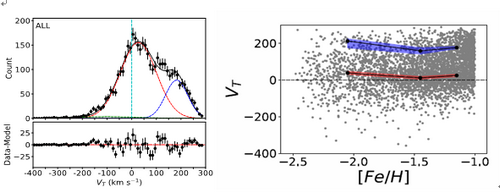Recently, Dr. Hao Tian, Professor Chao Liu and their collaborators from NAOC measured accurately the rotation speed of the halo in the solar neighborhood using K-giant stars from LAMOST DR5. The results have been published on The Astrophysical Journal.
The rotation of the halo is directly relative to the formation and the structure of the Milky Way. There are two main mechanisms for the halo rotation. Firstly, according to the CDM model, the halo grows by continuously accreting and merging satellite galaxies. The angular momenta of those ‘eaten’ galaxies will be contributed to the whole halo, making the rotation of the halo changed slightly. The other mechanism is that the halo absorbs the angular momentum from the bar because of the interaction during their evolution. Above all, accurately measure the rotation of the halo is quite important for understanding the formation and evolution of the Milky Way.
Dr. Tian, Prof. Liu and their collaborators obtained the accurate positions, velocities and metallicities of the K-giant stars by combining the catalog with Gaia DR2. Applying Bayesian method on 3827 K-giant stars with metallicity lower than -1, the rotation velocities of the components are measured. As shown by the red dashed curve in the left figure, the halo is rotating with speed +27km/s, and its dispersion 72km/s. The blue dashed line indicates that there is a metal poor component, which is rotating in a different direction, the metallicity distribution of these components is peaked between -1.9 and -1.6. It is possible to be part of the outer halo which was claimed by Carollo et al in 2007.
Difference with the results from literatures, the relation between the rotation velocity and metallicity is weak. The possible reason is that the velocity is reduced because of the remnant of a major merger, which was recently discovered by Helmi et al in 2018.

The left figure shows the rotation velocity distribution of the K-giant stars, the right figure shows the rotation velocity distribution of different halosubsamples (red) with different metallicity ranges.

Address: 20A Datun Road, Chaoyang District, Beijing, China code: 100012
Tel: 010-64888708 E-mail: naoc@nao.cas.cn

